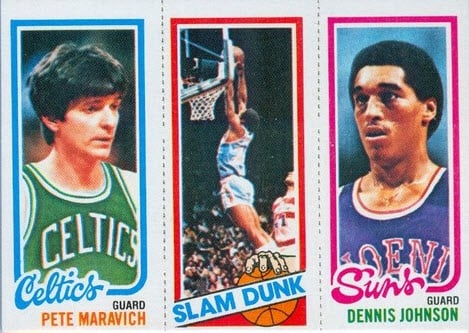1980-81 Topps Basketball: Taming a Perforated Monster

Basketball card collecting has many iconic rookie cards for collectors to chase. From George Mikan to Bill Russell. Lew Alcindor (later Kareem Abdul-Jabbar) to, of course, Michael Jordan. But none of them possess the sheer star power totality of the 1980-81 Topps Larry Bird/ Julius Erving/ Magic Johnson card.
Both Bird and Magic made their debut in the same year. Pairing them with an already established superstar like Dr. J and you have a classic. Unfortunately, the card comes from a set that has confounded collectors to this day. Allow us to explain.
The minds at Topps pulled off what seemed at the time like a cool marketing move. The company had long been tinkering with the size and scope of their annual basketball issue. The company’s first two sets after returing to the basketball market in 1969 featured cards that were tall and thin (much like the players themselves) and checked in at 2 1/2″ x 4 11/16”.
After a couple years of standard sized cards they changed up again in 1976, going big again with postcard sized cards at 3 1/8″ x 5 1/4″ each, before returning to the more common dimensions in subsequent sets.

When the 1980 season came around Topps went the opposite direction. They went small.
Each standard sized card was made up of three smaller cards, or more accurately, panels, that were perforated for easy separation. For kids in the day this might have seemed like a great deal. You buy a pack of cards with a piece of gum and eight cards, and you actually received 24 cards when they were torn apart. Most adult collectors opted to keep them together, but Topps was still marketing primarily to youngsters at this point.
Multi-player cards weren’t unique. It had been done before, in sets like the 1935 Goudey and Exhibit 4 on 1 cards. But this was the first time the manufacturer intended for the consumer to actually separate them into multiple cards.

If kids followed Topps’ plan, they were rewarded with 264 cards: twice as many as the previous three years. There was even a checklist on the back of the first eighteen cards to make collecting the entire set easy. However, with the way the cards were originally produced, Topps actually gave collectors three ways to complete the set.

The first way, of course, is to separate the cards for 264 different 1 1/6” by 2 ½” cards. However, keeping the cards in their original 2 ½” x 3 ½” unbroken size means a bit more explanation on the two other ways and requires understanding of how they were printed. To add to the confusion, the three card panels were all skip numbered so there’s no simple way to follow along even with a checklist.

Topps printed the cards on two different sheets. Each sheet contained half of the set printed twice. However the three card panels weren’t the same each half of the sheet. That meant each sheet contained 88 different three card…um..cards. With the two sheets, that meant there were 176 different cards making up a full set of regulation sized cards. That’s set number two, giving collectors two of every one of the 264 panels. Many checklists for this configuration can be found in guides and online.
However, what if you wanted to complete a set of 264 cards in the fewest number of regular sized cards as possible? There are very few resources on that what would be set version number three, but it’s fairly easy once you understand how the cards were laid out on the sheets when they were printed.

Think of each three-panel card as having a left, middle and center (let’s call them A-B-C) The left half of each sheet contained 11 rows of cards in four columns. Those were A-B-C. When the cards were reproduced on the right size of the sheet they changed the order on the three cards, but – and this is important – only the left card or “A” was changed. The center and right cards (B-C) were always together. That means the sheet contained half a set with A-B-C and a second half set with, let’s say, D-B-C. The A card appeared elsewhere on the sheet with a different B-C combo. To best explain let’s go back to the highly prized Bird-Erving-Magic. That combination appears on the sheet, but you will also find that same Bird panel on the left with Bill Cartwright and John Drew accompanying it. Erving and Magic show up with Jan Van Breda Kolff holding down the left panel.
Armed with that information we can easily produce a checklist that allows for completion of a full 264 card set using just 88 cards. They key question one must answer if they wish to go this route is; do you want to include the high-priced Bird-Erving-Magic card in your set or are you happy with Bird and Magic on separate cards? Both checklists are shown below. Since the skip numbering of the cards can be confusing, we’ve listed the cards alphabetically based on the player on the left panel of the card.
One final note: There are actually four ways to complete an 88-card set, but perhaps that’s a matter for another article.
Set #1 (no Bird-Erving-Magic)
AS-All Star, SL-Scoring Ldr, RL-Rebound Ldr, AL-Assist Leader, SD-Slam Dunk
Set #2 (with Bird-Erving-Magic)





